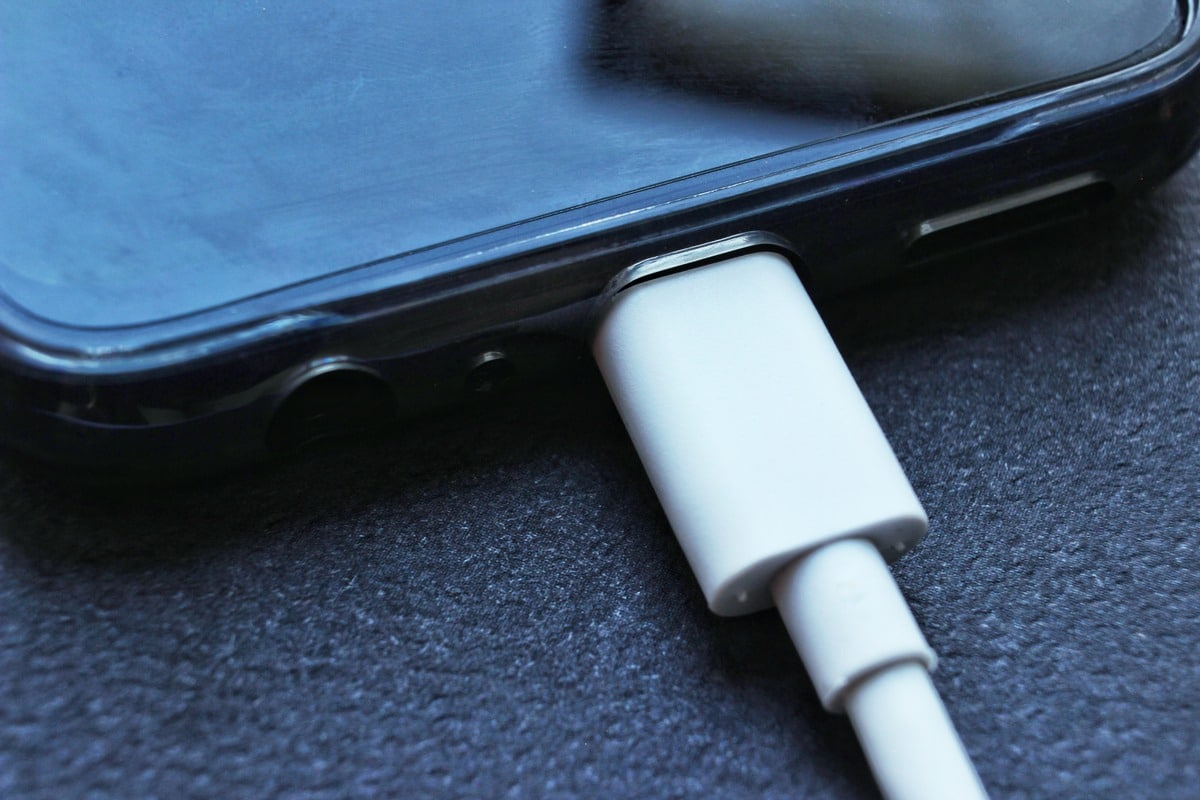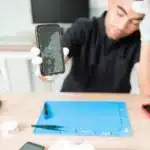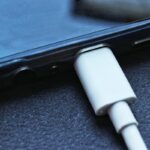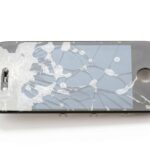
Many Android users run into charging issues and assume the cable or the battery is at fault. But sometimes, it’s just dust or tiny bits of dirt stuck inside the port that can interfere with the connection and prevent the phone from charging properly. Cleaning your phone’s charging port is fairly easy if you follow the right steps and use the right tools. In this blog, we will guide you through the signs of a dirty port, what causes buildup in the port, how to clean the charging port, what to avoid, and when to seek professional help.
Common Signs Your Charging Port Needs Cleaning or Repair
Before cleaning an Android charging port, it’s essential to understand the signs that indicate something is wrong.
Phone Not Charging at All
If the phone is not charging with a functioning cable, there is a chance that the port may be completely blocked. Lint, dirt, and tiny particles may prevent the connectors inside the port from making direct contact, which is necessary to start charging.
Charging Only at Specific Angles
Sometimes the phone only charges when you hold the cable at a particular angle. This occurs due to either debris stuck inside or slight damage inside the charging port. Angle-based charging is a sign that the internal connectors are obstructed or partially damaged.
Loose or Unstable Cable Connection
If the cable wiggles too much or easily falls out, this is another sign to look out for. While this may seem like an issue with the cable itself, it may indicate that the port’s internal pins are worn out or the port is filled with dirt.
Slower Charging Than Usual
Slow charging may be the result of an incomplete connection between the charger and the port. Even a small amount of debris can interfere with the efficient transfer of power. When this occurs, you may notice that your phone takes much longer to reach a full charge than it used to.
No Charging Icon or Intermittent Charging
From time to time, your phone may not display the charging icon, or the icon may flicker continuously, as if the phone is being plugged in and unplugged repeatedly. This intermittent connection disruption is caused by debris blocking the consistent flow of current.
Visible Dust, Lint, or Debris in the Port
If you can see lint or particles inside the port, you should clean it. This buildup accumulates when you store your phone in bags and pockets or expose it to a dirty or dusty environment. Even if the phone is charging normally now, leaving the debris and not cleaning your phone can increase the risk of charging issues in the future.
Why Charging Ports Get Dirty and What Happens When They Do?
Charging ports aren’t sealed. This makes them vulnerable to dust, fabric lint, and moisture, which can get inside the port easily. Gradually, this buildup affects the way your phone connects to the charger. This can lead to frustrating issues, such as slow charging, overheating, or a complete failure to charge. Below are some common causes of these problems and what the buildup can lead to if ignored.
Pocket Lint, Dust, and Debris Buildup
Most of us keep our phones in pockets, purses, or bags that collect small particles throughout the day. These bits of dust and lint gradually work their way into the charging port and settle around the pins, blocking the connection between the charger and your device. Even a thin layer of dust can interrupt the flow of power that charges the phone.
Although your phone may indicate that it’s charging, the battery continues to drain, and there’s no increase in the battery level. This can happen when something blocks the connection inside the charging port. Although the cable is plugged in, the power isn’t reaching the battery at all, and the phone doesn’t charge.
Exposure to Moisture or Humidity
When your phone gets wet, whether from rain, sweat, or steam from a shower, moisture can be trapped inside the charging port. This might not seem like a big deal at first, but over time, it can cause the tiny metal parts inside to rust. Once that happens, your phone may start charging slowly or stop charging without warning. If the port continues to be exposed to moisture, the damage will accumulate, making charging less reliable.
When the charging port becomes rusty due to moisture, it becomes harder for electricity to pass through. This can make your phone charge slowly, stop charging intermittently, or not charge at all. Some phones display a warning or stop charging until the port is completely dry.
Impact From Falls or Heavy Usage
Even if the port looks clean, physical damage from dropping the phone or plugging and unplugging the cable roughly can gradually loosen the port and cause damage to the pins inside, especially when debris is already present. This impact makes the port more vulnerable to future issues.
If your phone has fallen or taken a hit, the charging components inside can shift, causing intermittent or no charging. A loose connection like this can also make the phone overheat, since the power isn’t flowing properly.
Why You Must Be Careful While Cleaning the Port?
Cleaning your Android charging port may seem simple, but it’s easy to mess it up if you’re not careful, as the tiny parts inside can break or get damaged if you use too much force or the wrong tool. Even a small mistake can stop your phone from charging, so it’s always better to clean it gently and to take your time.
- Risk of damaging delicate internal pins
The small pins inside the charging port are responsible for making contact with the charger. If these pins get bent or scratched during cleaning, your phone may stop charging altogether. Since the space is tight, even a slight push with the wrong tool can cause damage that is difficult to repair.
- Can void your warranty
If your phone is under warranty, using the wrong tools to clean it can void the warranty. Brands often don’t cover damage like bent pins or damage, and signs that you’ve tried to fix it yourself. So if you’re cleaning the port, be gentle and use safe methods.
- May worsen the issue if done incorrectly
Trying to clean the port with objects such as metal pins, cotton swabs, or water can make things worse. You might unintentionally push the dirt in deeper or leave gunk behind. And if you don’t really know what’s inside the port, it’s easy to mess it up. What starts out as a bit of dust can end up breaking the port completely if you’re not careful.
Tools You’ll Need to Clean the Charging Port
The following items will help you safely remove dust and debris without damaging the delicate parts inside your phone’s charging port.
- Flashlight
A flashlight helps you see clearly inside the charging port. This lets you check for dust, lint, and damage before and after cleaning.
- Wooden or plastic toothpick
These materials are safe to use because they don’t conduct electricity and won’t scratch the internal pins. Avoid using metal tools, which can easily damage the port.
- Soft-bristled brush
A soft brush helps sweep out debris gently without damaging the internal components. An old, clean toothbrush works well if you don’t have a specialized brush.
- Can of compressed air
Compressed air can blow out loose dust and lint without any contact. It’s helpful for quick cleaning, but should be used carefully and from a short distance, so this tool is optional.
- SIM ejector tool
Only use this tool if you see a large piece of lint that’s stuck and isn’t reachable by a toothpick. It should be used with extreme caution due to its sharp tip.
- Isopropyl alcohol
If there’s sticky residue inside the port, a drop of 91% isopropyl alcohol on a toothpick or a brush can help dissolve it. Always make sure the alcohol fully evaporates before reconnecting your charger.
A Step-by-Step Guide to Cleaning Your Android Charging Port
The following guide will help you successfully clean the charging port without damaging it.
1. Power Off Your Phone
Before cleaning the charging port, always make sure that your phone is turned off. This prevents accidental short circuits and keeps you safe while working on the device. A powered-off phone also makes it easier to see inside the port without the screen lighting up.
2. Inspect the Port With a Flashlight
Use a flashlight to look inside the charging port, checking for lint, dust, and anything that looks out of place. If you notice any bent pins in the port, professional intervention may be required.
3. Use a Toothpick to Remove Debris Gently
Gently insert a wooden or plastic toothpick into the port to scrape the inside edges and lift out any lint or dirt. Avoid touching delicate parts, such as the center pins. Work patiently and don’t apply too much pressure.
4. Brush Out the Port
The best way to clean an Android charging port is to avoid pushing too hard or going in too deep, as this allows you to clear the dust without damaging anything inside. To prevent additional damage, use a soft brush to gently sweep out any remaining dust. Tilt it a bit to reach the corners, and use light, short strokes.
5. Use Compressed Air (Optional)
Hold the compressed air upright and spray short bursts of air into the port, maintaining a safe distance to prevent moisture from forming inside the propellant. Compressed air is especially helpful for clearing light dust you can’t reach with a brush. Avoid shaking the can or spraying for too long.
6. Use Alcohol Only if Necessary
Use isopropyl alcohol only if you notice a sticky buildup that doesn’t come off with brushing. Dampen a toothpick or a brush slightly—never pour alcohol into the port. Gently wipe the affected area and let it dry completely before powering your phone back on. Alcohol should be a last resort for stubborn residue.
What Not to Do While Cleaning?
Cleaning your Android device’s charging port may seem simple, but using the wrong tools or methods can easily damage your device.
- Never use metal objects, such as needles, pins, etc
Metal can scratch or bend the internal pins, which are essential for charging. It can also cause short circuits if your phone is accidentally powered on.
- Avoid water or liquid cleaners
Water can become trapped inside the port and damage the internal components. Stick to isopropyl alcohol, but only if there’s a sticky buildup.
- Don’t insert cotton swabs
Cotton tips can break off or shed fibers, adding more blockage inside the port. These fibers are hard to remove once they’re packed in.
- Don’t force anything inside the port
Applying too much pressure can damage or misalign the internal pins. If debris won’t come out easily, it’s better to seek professional help.
How to Determine if the Charging Port Is Still the Problem?
Avoid these common mistakes to protect your phone.
- Try multiple cables and a wall adapter.
Sometimes the problem isn’t the phone at all, but a faulty cable or adapter. Swap them out to see if this solves the issue.
- Test wireless charging.
If your phone charges wirelessly but not through the port, that’s a clear sign that the charging port is still the issue. It may be damaged or blocked.
- Use a diagnostic tool or app.
Apps such as Samsung Members and Phone Doctor Plus can test your phone’s hardware and detect charging issues. They’re free to use and give insights that can help you solve the problem.
- Check if the device charges in safe mode.
Booting your phone in safe mode turns off third-party apps. If charging works in this mode, a background app might be interfering with the charging process.
Other Causes of Charging Problems
Here are some additional reasons your device may not be charging properly.
A Faulty Cable or Charger
Even if your cable or charger looks like it’s in good condition, it may still not work, since it could be damaged inside. Try using a good-quality or original cable or charger. If your phone starts charging, then the port is likely not the problem.
Damaged Charging Port Pins
The tiny pins inside the charging port can bend or get dirty. This issue can prevent your phone from charging properly. Your phone may also only charge when you hold the cable a certain way. If that happens, you should get the charging port checked.
Software Glitches or Battery Calibration Issues
New apps and software updates can cause software problems, but restarting your phone often fixes them. You can also let the battery run out fully, then charge it to 100% to reset it. If that doesn’t help, use safe mode to check if an app is causing the issue.
Battery Health Deterioration
After a while, phone batteries get weaker and don’t last as long. If your phone charges but dies quickly or turns off on its own, the battery could be the problem. This problem is more common in older phones, but a new battery can help fix it.
Moisture Inside the Port
Even without visible water, humidity can leave behind moisture inside the port. Internal moisture can trigger warnings, prevent charging, and cause corrosion over time. Phones in tropical or rainy climates are more prone to this issue. Let the port air-dry fully before charging your phone.
When to Seek Professional Help?
These signs usually point to internal damage or something that requires professional repair beyond safe at-home fixes.
Port Feels Loose, or the Cable Doesn’t Stay In
If even a new cable falls out easily or wiggles a lot, the port may be worn or damaged. This usually means that the pins have loosened. A repair technician can check if the port needs tightening or a full replacement. Ignoring this issue may lead to complete port failure.
Charging Still Doesn’t Work After a Thorough Cleaning
If cleaning the port didn’t help, the problem may be deeper inside. Dirt might not be the issue; hardware damage or a faulty charging circuit could be the cause. Don’t keep forcing the charger in. Get your phone checked early to prevent further damage.
Moisture Warning or Charging Paused Messages
Phones often stop charging automatically when moisture is detected to prevent short circuits. If a warning message shows up frequently, even when the port seems dry, moisture may still be trapped inside. Corrosion can also trigger false alerts. If you’re unable to air-dry the phone yourself, a technician can safely inspect and dry the inside.
You Notice Corrosion, Bent Pins, or Internal Damage
Visible signs like rust, greenish buildup, or bent metal inside the port mean it’s time for professional help. These problems won’t go away on their own and can worsen over time. Trying to clean around damaged parts can make things worse, but repair experts can replace the port safely.
Phone Charges Only at Specific Angles
If you can only charge your phone at specific angles, the pins inside the port may be bent or damaged. You should check if this is a cable issue, but if the same thing happens with other chargers, the port is likely the problem. It may still charge for now, but the damage can get worse if ignored.
Unsure About Cleaning It Yourself
If you’re not sure how to do it, it’s safer to visit a repair shop, especially if your phone is pricey or still under warranty. A quick check can also prevent bigger problems later.
Phone Is Under Warranty
If your phone is still under warranty, opening or cleaning it yourself could void the coverage. It’s better to let an authorized technician take a look, and most brands will check your phone for free or at a low cost while it’s under warranty.
Preventive Tips to Avoid Future Charging Port Problems
Follow the tips below to prevent most charging issues before they even start.
- Use a port dust plug or a phone case with port covers
Dust plugs and cases with flap covers keep lint and debris from getting inside. They’re a cheap and easy way to protect your phone.
- Avoid charging in dirty or dusty environments
Try not to plug in your charger while at construction sites, outdoor events, or anywhere with a lot of dust, since it settles into the port easily.
- Store your phone in clean pockets or pouches
Avoid keeping your phone in pockets filled with tissues, lint, or loose items. Over time, debris builds up and clogs the port.
- Clean the port every 2-3 months
You don’t need to clean it weekly, but gently cleaning it every few months helps a lot. Regularly cleaning the charging port keeps the buildup from becoming a larger issue.
- Don’t jam the charger in
Never force the charger in; insert it gently. If you insert the charger forcefully, this may damage the internal pins or loosen the port. Always align the cable with the port and slide it in carefully.
Final Words
Be on the lookout for signs such as loose cables, slow charging, or the phone charging only at certain angles, as they usually indicate problems with the charging port. Cleaning it can get your phone working again, but if the problem continues, it’s best to talk to a professional. If you’re unsure or want expert help, reach out to Cell Phone Hospital. Our team can inspect, clean, or repair your phone’s charging port safely and quickly.
Frequently Asked Questions (FAQs)
You should clean it once every few weeks, or more often if you have been around dirt or dust.
Try a different charger and cable first. If that doesn’t help, take your phone to a repair technician.
Yes, but only if it’s 91% or higher and used in small amounts. Make sure the port dries fully before turning the phone on or connecting it to a charger.
You can easily damage the port if you use metal tools or apply too much pressure. Stick to soft, non-fibrous tools and take your time.





